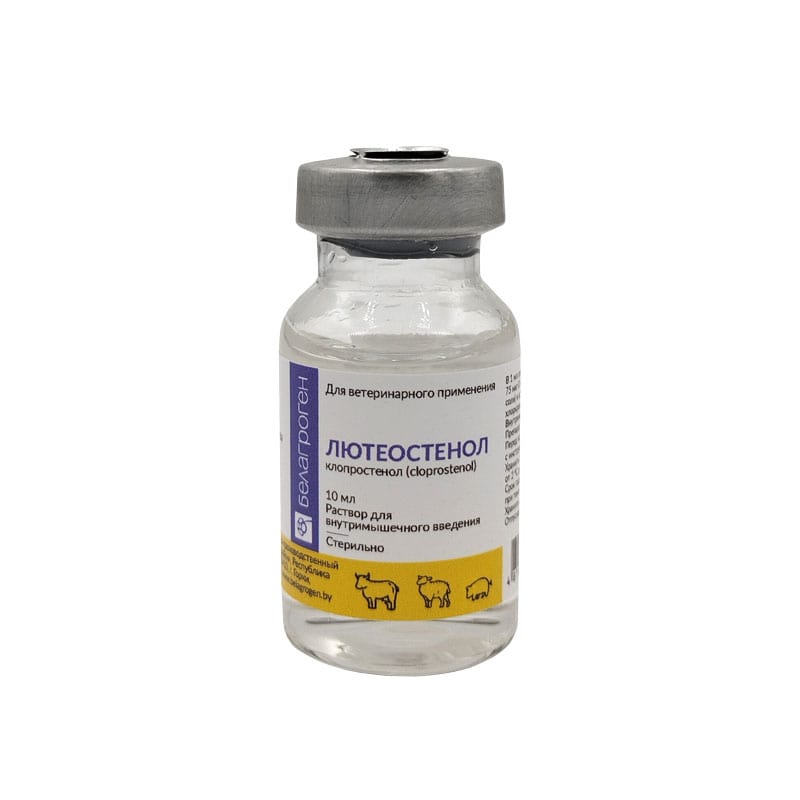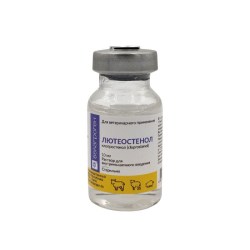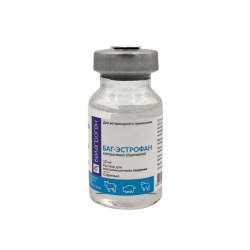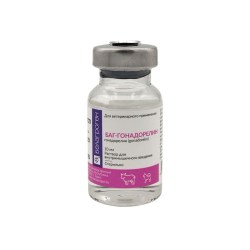Luteostenol
Veterinary drug LUTEOSTENOL
Regulation of the sexual cycle and treatment of gynecological diseases
- High biological activity of the active substance
- Fast-acting drug
- Estrous (heat) synchronization in cows and heifers
- Induction and synchronization of farrowing in sows
- For the treatment of cystic ovarian disease in cows
- For the treatment of the persistent corpus luteum in cattle
- For the treatment of postpartum endometritis and uterine involution in cows
- Treatment and prevention of incomplete dilation of cervix in sheep
- Termination of pregnancy (abortion) in animals
- No withdrawal period for milk
Therapeutic indications:
LUTEOSTENOL is used:
- for estrous (heat) synchronization in cows and heifers;
- for the treatment of cows with luteal and follicular cysts, persistent corpus luteum, subinvolution of the uterus and endometritis;
- for the treatment and prevention of functional ovarian diseases in pigs, induction and synchronization of farrowing in sows;
- for the treatment and prevention of incomplete dilation of cervix in sheep;
- induced termination of pregnancy in animals (for medical reasons).
Composition of the veterinary drug:
1.0 ml of the preparation contains:
- 75.0 µg of D-cloprostenol (in the form of sodium salt) as an active component.
Pharmacological activity:
The active substance of the drug is D-cloprostenol, a dextrorotatory optical isomer of cloprostenol, a synthetic analogue of prostaglandin F2α. D-cloprostenol has biological activity 3.5 times higher than cloprostenol (racemic mixture of DL-cloprostenol).
Luteostenol has a luteolytic action on the corpus luteum of ovary, reverses the inhibitory effect of progesterone on the hypothalamic-pituitary complex, contributing to:
- the growth of follicles in the ovaries,
- the estrogen blood levels rise,
- the manifestation of estrous behavior,
- heat induction,
- subsequent ovulation of mature follicles.
The period from the drug administration to the first signs of estrus is 48-60 hours.
The drug enhances the contractile function of the uterus and exhibits a biological effect only in the presence of actively functioning yellow bodies in the ovaries.
In animals, D-cloprostenol is rapidly metabolized and excreted with urine within 24 hours.
Dosage:
Before using the drug, carry out a gynecological examination of animals.
The drug is administered intramuscularly in the following doses and regimens.
- Estrous synchronization in cows and heifers: 2 ml of the drug (150 µg of D-cloprostenol) is injected twice with an interval of 11 days between injections. The first dose of the drug is administered at any phase of the sexual cycle (in cows – starting from 40th to 60th day after parturition). After 72 hours and 96 hours after the second injection of the drug, double artificial insemination is carried out (regardless of the external signs of heat).
- Induction of estrus in cows and heifers (also in cases of split and silent heat): 2 ml of the drug (150 µg of D-cloprostenol) is injected after the corpus luteum detection in the ovaries (from the 6th to 18th day of the sexual cycle), heat usually shows up within 48-60 hours. Therefore, artificial insemination must be carried out 72-96 hours after the injection of the drug. If estrus does not start, repeat the injection of the drug 11 days after the first administration.
- Induction of parturition in cows: 2 ml of the drug (150 µg of D-cloprostenol) is administered after 270 days of pregnancy. Calving should occur 30-60 hours after injection.
- In case of follicular ovarian cysts, cows are injected subcutaneously with chorionic gonadotropin at a dose of 4-5 thousand IU. Also cows may be injected intramuscularly with surfagon at a dose of 5 ml for 3 consecutive days. After 11 days, the animals with no estrous signs are injected with the drug at a dose of 2 ml (150 µg of D-cloprostenol).
- In cows with persistent corpus luteum, luteal ovarian cysts, the drug is administered at a dose of 2 ml (150 µg of D-cloprostenol). Artificial insemination is carried out as soon as the first signs of estrous appears. If estrous does not occur, then 2 ml of the drug should be injected one more time 11 days after the first injection, followed by artificial insemination 72-96 hours later and according to the instructions.
- For the treatment of cows with postpartum endometritis, pyometra, the drug is administered at a dose of 2 ml (150 µg of D-cloprostenol), if necessary, the injection of the drug is repeated after 10-11 days.
- For the treatment of cows with subinvolution of uterus, the drug is injected at a dose of 2 ml (150 µg of D-cloprostenol), if necessary, the injection of the drug is repeated after 24 hours.
- To restore reproductive function in sows with no signs of estrous after 12 days of piglets weaning, the drug is injected at a dose of 1 ml (75 µg of D-cloprostenol) in combination with one of gonadotropic drugs (pregnant mare serum (PMS) at a dose of 10 IU per 1 kg of body weight, etc.).
- To synchronize farrowing in sows and to prevent postpartum diseases, the preparation is prescribed at a dose of 1 ml (75 µg of D-cloprostenol) on the 113th day of pregnancy, then the drug administration is repeated after 6 hours. As an alternative, 20 hours after the first injection of luteostenol, a stimulator of myometrium (uterine muscle) such as oxytocin may be administered. When following a protocol with two injections, in 70-80% of animals, parturition occurs within 20-30 hours after the first injection.
- For the treatment and prevention of incomplete dilation of cervix in sheep, the drug is administered at a dose of 2 ml (150 µg of D-cloprostenol) 15-16 days before the expected lambing. In cases of complete vaginal prolapse occured 3-5 days before parturition, the drug is administered in the above-mentioned dose in combination with 2 ml of 0.1% oily solution of estradiol dipropionate.
- Termination of an unwanted pregnancy (for medical reasons) is achieved by the drug administration at a dose of 2 ml (150 µg of D-cloprostenol).
The injection site should be thoroughly cleaned and disinfected to eliminate the risk of infection with anaerobic bacteria (clostridium, etc.).
Precautions and adverse reactions:
When the drug is used in accordance with all these instructions, side effects and complications are generally not observed.
Do not use LUTEOSTENOL in pregnant females, except in cases of the forced termination of pregnancy or induction of parturition.
The use of the drug in sows up to 113 days of pregnancy may have a negative impact on the viability and weight of the newly born piglets. The drug is prescribed only when the exact date of insemination is known.
After the first administration and cancellation no peculiarities are revealed.
Overdose symptoms are usually not observed. In case of overdose, use symptomatic therapy. In the case of an allergic reaction, the drug should be cancelled; antihistamines and calcium preparations are prescribed.
Avoid missing the next dose of the drug, as it may lead to the reduced therapeutic effect. If administration of the veterinary drug is missed, resume it in the same dosage and according to the same treatment regimen.
Do not use the drug in animals treated with non-steroidal anti-inflammatory drugs, since the synthesis of endogenous prostaglandins will be inhibited.
Withdrawal period:
Animals should not be slaughtered for human consumption within 24 hours after the last treatment. Meat of animals forcibly slaughtered earlier than the specified period expires may be used for feeding carnivores.
Milk may be used for human consumption without any restrictions after the last drug administration.
Storage conditions:
Store in a dark place at a temperature between + 2 ° C to + 25 ° C.
Shelf-life:
Shelf-life of the veterinary drug is 2 years from the date of manufacture. Shelf-life after first opening of the bottle (vial) is 28 days under appropriate storage conditions at a temperature between + 2 ° C to + 8 ° C.






 BAG-Estrofan
BAG-Estrofan BAG-Gonadorelin
BAG-Gonadorelin BAG-Surfagon
BAG-Surfagon